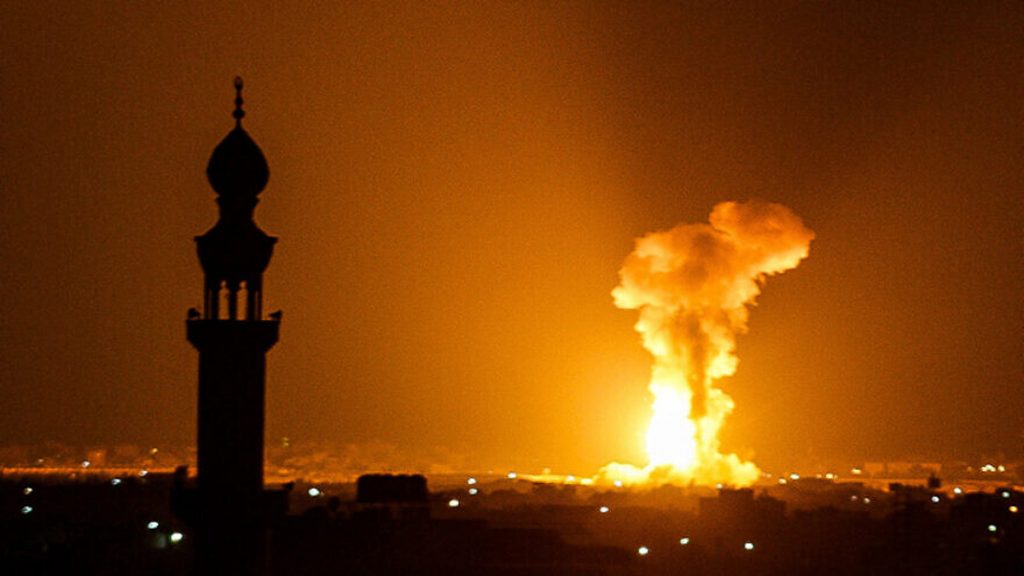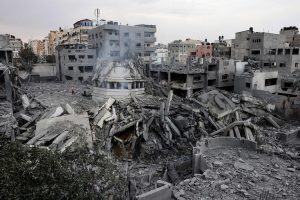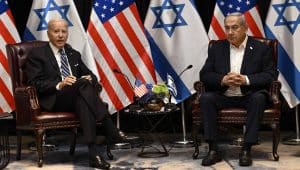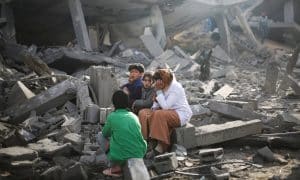To justify itself, state terrorism manufactures “terrorists”: it sows hatred and harvests alibis. Everything indicates that this carnage in Gaza, which according to its authors wants to put an end to “terrorists,” will succeed in multiplying them. —Eduardo Galeano, 2014
From August 5 to 7, the Zionist state of Israel carried out a round of attacks on the Gaza Strip dubbed Operation Breaking Dawn. According to Prime Minister Yair Lapid, it was a “preemptive strike” against the armed group Palestinian Islamic Jihad (PIJ), which had been planning to attack Israel. Once again we have witnessed an Israeli massacre against Palestinians, one that ended with the killing of 44 people, including 15 children, according to the Palestinian health ministry in Gaza. More than 350 were wounded, and at least 1,500 homes were destroyed or damaged. This is the latest assault in the process of colonization that has been underway since 1882.
Beginnng with a discussion of this criminal act, we will conduct an analysis of the current situation from both a tactical and a strategic point of view, and see how they are intrinsically linked to each other and to the debates around the Palestinian organizations.
Notes on the Current Situation
On the night of August 1, Israeli occupation forces arrested PIJ leader Bassam Al-Saadi in Jenin, the same city in the West Bank where Al Jazeera journalist Shireen Abu Akleh was recently assassinated. “Anticipating” a military response from Gaza (where the PIJ has its largest concentration of weapons and fighters), the Zionist government put security measures in place along the border separating the occupied Palestinian territories and the Gaza Strip under the pretext of a potential attack. Egypt (a U.S. ally) intervened in this crisis as a mediator between the Israeli occupation government and the PIJ movement. It was able to persuade the PIJ to freeze any possible military action on its part.
The occupying state of Israel, however, built up military forces on the Gaza border, with the support of U.S. imperialism (under the premise of the “right to self-defense”) — closing settlements in the southern region, reinforcing forces, and calling up to 25,000 reserve troops — not as a “defensive” maneuver but in preparation for the so-called preemptive strike. First they bombed the apartment where the commander of the PIJ’s northern region, Tayseer al-Jabari, was killed, along with other fighters and several Palestinian civilians. The PIJ responded with rocket attacks amid three days of Israeli bombardment, until Egypt “mediated” a cease-fire last Sunday night. But this cease-fire stands on shaky ground, since Israel usually resolves its internal political crises through wars with Gaza or other regional enemies.
Elections and “National Interest”
With the approach of the fifth election in almost three years in the Jewish state, the Zionist electoral field is marked by total uncertainty. Benjamin Netanyahu might even return.
Lapid, together with his minister of defense, Benny Gantz, are now using the tactical triumph to turn it into a strategic one, positioning themselves as a “strong government” in the face of the perceived “Palestinian threat” for attacking Israeli towns and cities from Gaza with rockets (mostly intercepted by the Iron Dome anti-aircraft defense system) and incendiary balloons, and after armed attacks left about 15 Israelis dead at the beginning of this year. In other words, they had to prove that they could guarantee the security of the “average Israeli.”
While not all Israelis share this colonialist paradigm, given that some oppose the occupation of the West Bank and want “peace,” there is a right-wing social base that pressures the government to be more aggressive. Since the Second Intifada, in 2002, the ultraright, nationalist-religious sector has grown, many of whose members have settled on Palestinian lands. They spearhead Israel’s policy of dividing the Palestinian movement in territorial terms, hindering the creation of a Palestinian state.
Another sector of the establishment and the middle class sees the occupation as an anachronism that has persisted since the end of the Cold War. The forms of accumulation by the dispossession of Palestinian lands and resources are associated with production and investment through the military apparatus (surveillance technology and state-of-the-art weapons). In this undertaking, the state serves as the guarantor of subsidies — always generating public deficits, but also large profits to military technology companies that use the occupation to sell weapons that are “tested in combat.” Meanwhile, the globalist and financial private sector perceives the occupation as an obstacle to opening the playing field and positioning itself in nonmilitary terms in the world market.
Lapid represents this politically weak sector of the bourgeoisie concentrated in Tel Aviv, which seeks to limit the occupation (including the settlements) and transform it into a “war of precision.” This, however, stands as a “secondary” subject when approached from the Israeli perspective that there is a “national interest” in dividing the Palestinians geographically, politically, and ideologically by generating friction between them.
In this context, the calculation for attacking Gaza was crucial. It was impossible to predict with certainty whether Hamas would join the military response, but several structural factors heralded a political triumph for the interim government. For one, Hamas is trying to rebuild several Palestinian cities after the lethal 2021 war. Israel is “allowing” humanitarian aid, materials, and money (mainly from Qatar, which announced a new aid package) to come in, in exchange for Hamas not engaging in actions against Israel. Hamas is looking for ways to solve its funding problems, which are exacerbated by rising import costs for the resource-poor Gaza Strip.
Recently, the implementation of a tax increase on merchants generated a small protest, and in July the salaries of government workers were cut, showing that increasing the tax burden on the population can undermine popular support for Hamas. It also showed weakness by “allowing” occupying Israel to bomb with impunity, which deepened friction with the PIJ.
The interim government’s calculation will likely give it some leverage in the upcoming elections. But the internal instability of Israel’s politics constantly brings new surprises, which it would not be unusual for them to seek to resolve with forthcoming attacks on the Palestinians.
Devastation on the Shores of the Mediterranean Sea
To understand why bombs are cyclically raining down on this small part of the world, we must analyze Gaza’s significance to Israeli domestic politics.
The Gaza Strip is the largest open-air prison in the world; 2 million Palestinians are cornered by sea, land, and air. The occupying Israeli army has invaded it in more than a dozen high-profile operations since 2000 1The most important were: Operation Cast Lead (2009), Operation Pillar of Defense (2012) Protective Margin (2014), and the most emblematic recent one was Guardian of the Walls (2021). Between them, thousands were killed and wounded, many of them children, with terrible psychological after-effects for the survivors., the majority taking place since its withdrawal in 2005 at the end of the Second Intifada. Hamas, an acronym for “Islamic Resistance Movement,” has governed Gaza since it triumphed in the 2006 elections — which is precisely why they are not recognized — and prevented a coup d’état in 2007 organized by Fatah and Israel. Thus, Israel’s Security Cabinet declared it a “hostile entity,” tightening restrictions on Palestinians’ mobility in the territory. The entry of goods and services was reduced to what occupying Israel defines as the “humanitarian minimum,” the export of goods was banned, the import of fuel was reduced, and travel (which was already limited) between Gaza and the West Bank and Israel was minimized to the extreme. Israel began its “separation doctrine” to erode cultural, family, and identity ties, as well as ethnic and territorial continuity.
The false pretext for these attacks is the “Palestinian terrorist threat,” even though Palestine is a political-territorial entity whose inhabitants have an extremely deteriorated standard of living. At the same time, Israel also seeks to increase its power in the Middle East with the support of the United States, and to end the Intifada and restore the humiliation caused by 20 years of war in Lebanon against Hezbollah. This serves to deter Israel’s enemies, to present its tested-in-combat weapons and “know-how” as a model of capital accumulation, and serve as a “security policy” for Israeli settlers.
Operation Breaking Dawn is part of this modus operandi in the context of the internal political crisis in Israel. It is also an unbearable burden on the Palestinians, one that has turned into a popular and unyielding resistance. To achieve Palestinians’ surrender, Israel deploys various tactics of control and surveillance — but above all, of dividing and disciplining — in order to conquer.
Disciplining the People
The Zionist state of Israel has been conducting an offensive against Palestinians in the West Bank 2Unlike Gaza, the West Bank suffers from other types of restrictions linked to the daily military occupation in much of that territory with checkpoints, roadblocks, and soldiers blended into the daily landscape. Israel’s official documentation calls this territory Judea and Samaria, a biblical territory which it aspires to conquer in the long term on the basis of Palestinian ethnic cleansing and to constitute a “Greater Israel.” This is a project of the most radical Zionist wing, combining nationalism and religion. It is arguably the most aggressive and its weight is growing steadily within Israeli society. Territorial aspirations reach parts of Iraq, Saudi Arabia, Syria and Egypt. on the grounds of self-defense since the end of 2021. Although they justify themselves on the basis of individual armed attacks in Israeli cities, the army raids that ravaged Jenin and Nablus to the north, and Hebron to the south (especially in the refugee camps where the social situation is very precarious), were aimed at disciplining the popular resistance (especially of young people), which questions both the occupation and the traditional Palestinian leadership.
These cities also have a long tradition of armed resistance. Today, the PIJ has an important influence among the youth who seek different ways to fight the occupation. This is not a minor issue, taking into account the conditions in which the Palestinian population lives: high rates of unemployment, poverty, extreme surveillance, border control, military harassment, etc.
In 2021 the situation worsened as a result of the Israeli advance against the Palestinian neighborhood of Sheikh Jarrah and the oppressive policy of the Netanyahu administration against the worshippers who traveled to the al-Aqsa mosque in Jerusalem — Haram al-Qudsi al-Sharif — to pray during Ramadan. Hamas began firing rockets at Tel Aviv, which provided the pretext for 11 days of Israeli bombardment of Gaza, leaving 300 dead, thousands wounded, and hundreds of buildings destroyed.
But this offensive was met with what Israel feared most: a unified Palestinian movement against the bombings, fighting both in the streets and with a political program. The ultimate expression of this was the general strike of Palestinians across several territories: the West Bank, Gaza, those living in the diaspora (millions living in refugee camps in Jordan and Lebanon), and those living in the so-called ’48 territories (the so-called Israeli Arabs, living in what is now Israel). After a few days, the strike fizzled out with some isolated resistance. This was largely owing to the policy of the Palestinian Authority, which, in order to maintain its privileges, sought to defuse this movement, which questioned the basis of the Oslo agreement and the rulers of not only Fatah but also Hamas and even leaders of the PFLP (Popular Front for the Liberation of Palestine). Thus, the lack of a unified (and revolutionary) political leadership to organize the youth resulted in the loss of the strategic direction of the movement to confront Israel and fight the traditional leaderships. The Palestinian resistance, however, still maintains a national identity and can articulate itself politically, despite both its leadership and the segregation and colonialism of the Israeli occupation.
Now, a year after that fight, Israel has dedicated itself to selectively increasing repression; it has targeted the leaders of some political parties that present a certain continuity of struggle, such as the PIJ, but with an eye on both popular resistance (as seen in Beita, Nablus) and armed resistance, which is often organized outside the political leaderships (evidenced by the number of militants killed in clashes with links to several groups at the same time or sometimes none at all). For Palestinians, it is central to resist the occupation in the face of a totally truncated lifespan — without jobs, without permission to move, and in the face of increasing poverty. As we write these lines, the killings of Palestinians are increasing. According to the Israeli daily Haaretz, of the 60 cases in which Palestinians were killed in “incidents” involving the Israeli occupying army (IDF — Israel Defense Forces) and the Border Police in the West Bank, 16 are currently being investigated by the Military Police. There were 70 such deaths in all of 2021, and 20 in 2019.
Gaza and the Fragmentation of the Palestinian Movement
To understand part of the current situation of the Palestinians, we must go back to 1979, an important year for the Middle East and the world. That year, Arab nationalism, particularly Egyptian nationalism (Nasserism), showed its great historical limits when Egypt signed peace with Israel, abandoning the Palestinian cause as the axis of its regional policy. At the same time in Iran, the revolutionary process was unleashed, leading to the imposition of Khomeini’s Islamic leadership, which would have an ideological impact on the whole region, both in Shiite and Sunni Islam. The war in Afghanistan began with the Soviet invasion, where Saudi Arabia (Sunni) took advantage to extend the influence of Wahhabism 3A rigorist current of Sunni Islam originating in Saudi Arabia.. In 1980, the Iran-Iraq War began as a reaction to the Iranian Revolution. Those years opened a stage for the development of new ideologies linked to political Islam, which also consolidated around defeating the workers’ movement and its leaderships, such as the communist parties, which often supported regimes such as that of Nasser in Egypt, the Baath in Iraq and Syria, or even the rise of Khomeini in Iran, for geopolitical reasons that benefited the USSR.
Thus, Fatah (representative of Palestinian Arab nationalism) began to weaken in the face of the emergence of new Palestinian organizations. Among them, the PIJ was founded in 1981 within the framework of the “Islamic Republic” in Iran (Shiite), which generated the political conditions for the growing influence of the Muslim Brotherhood (Sunni) since the defeat in the 1967 war. Although recognized as Sunni within Islam, the organization is broader in religious terms, with a nationalist-bourgeois (Arab-Palestinian) program but with the objective of achieving an Islamic state, which gives it enough flexibility to establish alliances. Its guerrilla strategy allowed it to absorb PFLP militants who sought to continue the armed struggle after the fall of the USSR.
Soon after, Hamas emerged in 1987, also in Gaza, amid these regional influences (Hezbollah in Lebanon, Islamic Salvation Front in Algeria) during the First Intifada — which began as a movement without political direction, with weekly general strikes and strong revolts. The beginning of the Oslo Accords in 1993 4The West Bank region was divided into 3 administration areas: A, B and C, with its design being similar to that of an archipelago. A are areas of administration and security under the Palestinian Authority which would be transformed into a semi-autonomous government; B are areas controlled by a hybrid between the Palestinian municipality and the military in the hands of Israel; and C are areas where the public and military administration woudl be fully in the hands of Israel. At the same time, this did not stop the advance of the settlements but the expropriation of Palestinian land by various mechanisms deepened. The agreements left the window open for the continuation of this policy. were part of a way out for both Israel and the Palestinian Liberation Organization (PLO, which was left without its Soviet ally after 1991) to discipline that situation, in which many had great expectations to return to their homes and improve their living conditions. From that moment on, Israel managed to “delegate” a large part of the social administration and security tasks to the constituted Palestinian Authority in the West Bank and Gaza (until 2007), but owing to its authoritarian policy and submission, it gradually lost the effective leadership of the Palestinian movement. This subjugation caused material conditions of precariousness and proletarianization of the vast majority of Palestinians.
As a result of this political and economic defeat of the Palestinians, the Second Intifada began, in which once again the collaborationist character of the PLO deepened. Thus, toward the 2006 elections, Hamas presented itself to the Palestinian parliament with a 39-point reformist program 5Among them was the right of return of all refugees expelled by the State of Israel and the recognition of resistance in its various forms as a legitimate right of the Palestinian people to end the occupation and regain national rights, improve the living conditions of citizens, encourage social solidarity, expand the health and education network and develop services for the population., taking a bourgeois nationalist perspective toward the Palestinian conflict. This brought new expectations, especially for Gazans.
The years of military occupation and colonization, coupled with these political defeats, pushed the majority of Palestinians toward the two Intifadas, to question their leadership, and even toward more radical ideologies, such as political Islam and armed struggle as a last resort. An example of this is a recent Israeli raid in Nablus that claimed the life of a young fighter, Al-Nabulsi. Although his father belongs to the Palestinian Authority, he had no clear organizational affiliation and was in contact with members of Tanzim, a group of Fatah activists, many of whom resumed armed struggle against the IDF in the last two years outside the central leadership. In Nablus and Jenin, local cells composed of members of various organizations are ready to take up arms against any military operation in the Palestinian cities without the approval of their leadership.
On the other hand, there are Hamas, Islamic Jihad, and other groups whose political programs and methodology aren’t necessarily combatable, but who share a common enemy: the Zionist colonial project. Before the founding of these political organizations, there was ethnic cleansing, massacres, settlements, and mass imprisonment by Israel.
The Zionist state of Israel was built on the bones of the Palestinians; it is sustained by policies of aggression, uprooting, and apartheid against the native peoples with a colonialist logic and as an imperialist armed wing. The result is that all attacks against Gaza, regardless of the pretext, take place in this context of annexations, construction of segregation walls, legal and “illegal” or outpost settlements, and Israeli checkpoints in the West Bank. This, without mentioning the invention of “firing zones” to displace shepherds’ villages. 6Today we see it in the hills of Masafer Yatta where hundreds of families are being dispossessed of their land. See: Siege and resistance in the southern West Bank.
But, on the other hand, we see that the bourgeois and petty-bourgeois parties we have analyzed, such as Fatah, Hamas, and the Islamic Jihad, have proven incapable of achieving any “national liberation.” And given their international alliances (as in the case of Qatar with Hamas, or Iran with Islamic Jihad, or limited U.S. funding in the case of Fatah), the prospects are clearly far removed from the struggle for true self-determination for the Palestinian people.
The situation for the Palestinians is worsening in this new stage of the world crisis. But it could open up new possibilities, considering that in several countries of the world, and especially in the Middle East, we have seen strong revolts. The path of the national general strike adopted by the Palestinians in 2021 showed their capacity to fight and build independent organization to impose an agenda of their own, despite the traditional parties that have shown themselves time and again as collaborators of the Zionist state of Israel.
Sources
Étienne, Bruno. 1996. Radical Islam. CITY: Siglo XXI.
Finkelstein, Norman. 2015. Method and Madness: The Hidden History of Israel’s Attacks on Gaza. CITY: Akal.
Kepel, Gilles. 2002. La Jihad. CITY: Paninsula.
Pappé, Ilan. 2015. The Idea of Israel. CITY: Akal.
Sayigh, Yezid. 1997. Armed Struggle and the Search for State: The Palestinian National Movement, 1949–1993. Oxford: Oxford University Press.
First published in Spanish on August 14 in La Izquierda Diario.
Translation by Luigi Morris
Notes
| ↑1 | The most important were: Operation Cast Lead (2009), Operation Pillar of Defense (2012) Protective Margin (2014), and the most emblematic recent one was Guardian of the Walls (2021). Between them, thousands were killed and wounded, many of them children, with terrible psychological after-effects for the survivors. |
|---|---|
| ↑2 | Unlike Gaza, the West Bank suffers from other types of restrictions linked to the daily military occupation in much of that territory with checkpoints, roadblocks, and soldiers blended into the daily landscape. Israel’s official documentation calls this territory Judea and Samaria, a biblical territory which it aspires to conquer in the long term on the basis of Palestinian ethnic cleansing and to constitute a “Greater Israel.” This is a project of the most radical Zionist wing, combining nationalism and religion. It is arguably the most aggressive and its weight is growing steadily within Israeli society. Territorial aspirations reach parts of Iraq, Saudi Arabia, Syria and Egypt. |
| ↑3 | A rigorist current of Sunni Islam originating in Saudi Arabia. |
| ↑4 | The West Bank region was divided into 3 administration areas: A, B and C, with its design being similar to that of an archipelago. A are areas of administration and security under the Palestinian Authority which would be transformed into a semi-autonomous government; B are areas controlled by a hybrid between the Palestinian municipality and the military in the hands of Israel; and C are areas where the public and military administration woudl be fully in the hands of Israel. At the same time, this did not stop the advance of the settlements but the expropriation of Palestinian land by various mechanisms deepened. The agreements left the window open for the continuation of this policy. |
| ↑5 | Among them was the right of return of all refugees expelled by the State of Israel and the recognition of resistance in its various forms as a legitimate right of the Palestinian people to end the occupation and regain national rights, improve the living conditions of citizens, encourage social solidarity, expand the health and education network and develop services for the population. |
| ↑6 | Today we see it in the hills of Masafer Yatta where hundreds of families are being dispossessed of their land. See: Siege and resistance in the southern West Bank. |










